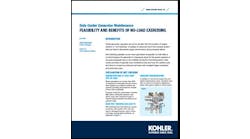Partnering With Reliable Colocation Providers Reduces Risk
In this edition of Voices of the Industry, Robert McClary, COO, FORTRUST at Iron Mountain, shares some of the ways partnering with reliable colocation providers reduces risk for unplanned outages.
Robert McClary, COO, FORTRUST at Iron Mountain
Few things strike as much fear and frustration into the hearts of modern businesses than these two words: unplanned outage. When this type of unplanned downtime occurs in a data center, many times the entire organization can come to a screeching halt. Revenue engines can be interrupted, important data can no longer be accessed, communications may be hampered and productivity can grind to a halt. The simplest of daily tasks and duties suddenly become much more time consuming and complex – if not altogether impossible. With each passing moment of IT or network downtime, more and more of the business’s money trickles down the drain. What a waste! Although these types of interruptions occur all too frequently in the corporate world, it doesn’t necessarily have to happen to YOUR organization. In fact, enterprises that partner with reliable colocation data centers can significantly reduce the risk of unplanned outages and corporate downtime. The best colocation providers will have strong strategies for preventing outages and mitigating potential risks that can also impact availability.
There is no substitute for uptime. In fact, there isn’t even a close second. Our ever-increasing reliance on technology for business and day to day life has led to an increased need for reliability and the avoidance of unplanned downtime. Over the course of many years we surveyed our colocation customers annually and asked the same question.
Question: Before you were a customer, what were your top criteria in choosing a data center?
The number one response year after year is the same: The reliability of the critical systems infrastructure.
[clickToTweet tweet=”Robert McClary – Before you were a customer, what were your top criteria in choosing a data center?” quote=”Robert McClary – Before you were a customer, what were your top criteria in choosing a data center?”]
Unplanned outages are obviously just that – unplanned. Understanding the most likely causes of unplanned downtime will help focus your due diligence efforts and increase your chances of avoiding the unplanned outage.
Here’s a closer look at three key components that lead to downtime in data centers. Understanding these can help you avoid downtime for your organization.
Human error is the most likely cause of downtime
Its number one folks! It is also the number one excuse for outages. Why? Because we tend to accept it easier. However, human error is not unavoidable; it just requires discipline. And to the dismay of many, it’s not cured by the design of the data center infrastructure or software. Believe me when I say, I’ve seen designs so complicated in the effort to try to avoid human error it creates the opposite outcome. I’ve also seen software fail just as often as the human being – or have we stopped using the word “bug” when it comes to software yet? That alone should tell you something. Human error can be mitigated to the point that it becomes a “less likely” cause of downtime.
What can you do to guard against unplanned downtime? Make the focus of your due diligence efforts when selecting a colocation provider on the discipline in which they conduct their operations. This will tell you more about what you’re buying and what the likelihood of suffering unplanned downtime will be.
Maintenance is a priority for long term reliability
Concurrently maintainable is just that. If you don’t maintain it – it will break at some point. It doesn’t matter how new your equipment is, if you aren’t taking care of it, neglected equipment is more likely to fail and lead to downtime. When your IT environment and equipment is housed in a colocation data center, you have a vested interest in the level of preventive and predictive maintenance that the data center infrastructure is receiving.
What can you do when it comes to selecting your colocation partner? Check the maintenance and testing history on the entire infrastructure. And by the way – if they are truly Tier III or concurrently maintainable, this can and should all be accomplished without impact to your colocated IT environment!
Consider the location
[clickToTweet tweet=”Robert McClary – Location is critical to mitigating the risks associated with unplanned outages. ” quote=”Robert McClary – Location is critical to mitigating the risks associated with unplanned outages. “]
Location is critical to mitigating the risks associated with unplanned outages. If recent news stories have taught us nothing else, it’s that certain geographical regions are simply more prone to being hit by disasters. Data centers that are situated along the coastal regions run the extreme risk of being hammered by flooding, tropical storms and hurricanes that can impact the most redundant of data center designs. Other regions, namely those along the west coast, are often subject to earthquakes that can negatively impact. Whether or not your business is specifically located in these regions, it’s in your best interest to look for a colocation data center that is located outside of areas that are prone to natural disasters.
These are three of the most likely causes of downtime in a data center. If you’re looking for an even greater level of due diligence, try utilizing a third party validation such as the Uptime Institute’s Certification of Operational Sustainability, which checks each of these three components in significant detail.
Robert McClary is Chief Operating Officer at, FORTRUST at Iron Mountain. FORTRUST was acquired by Iron Mountain in July of 2017.






